People visit temples in Egypt for a variety of reasons, influenced by historical, cultural, spiritual, and personal factors.
Here are some important and must read facts about the most visited Temples in Egypt.
Table of contents
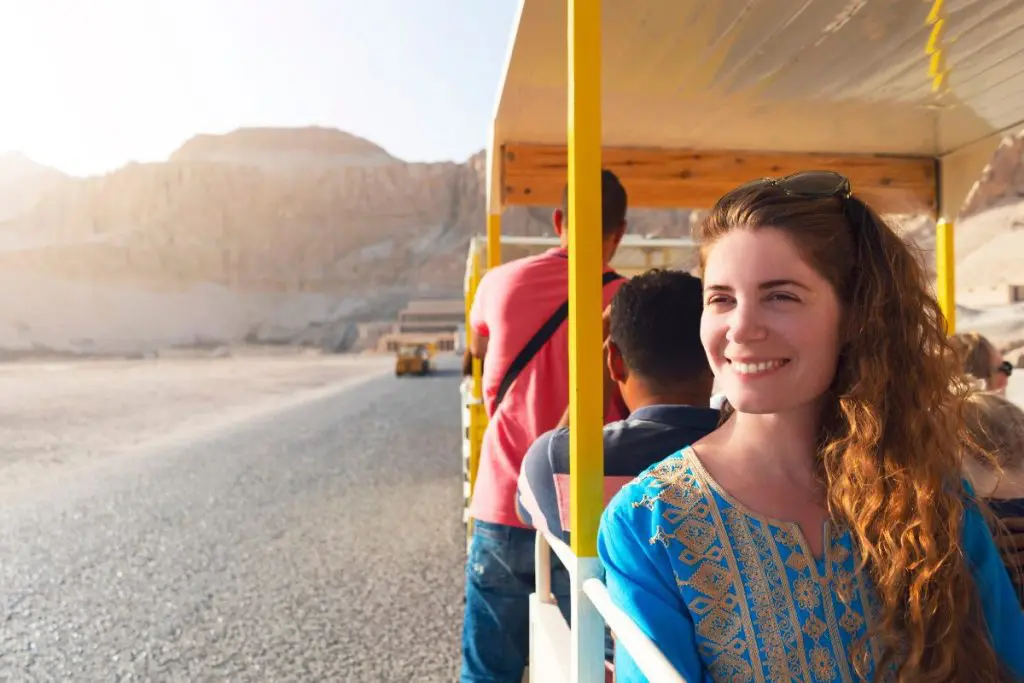
The country’s rich heritage, particularly its ancient Egyptian civilization, draws individuals seeking to explore remnants of the past. The temples, known for their impressive architecture and engineering, featuring massive structures, intricate carvings, hieroglyphics, and colossal statues, appeal to those interested in art and architecture.
For some visitors, the spiritual and religious aspects of ancient Egyptian culture are a significant draw. Many temples were dedicated to gods and goddesses, providing a way for individuals to connect with the beliefs and practices of a bygone era. The mystique and mystery surrounding the ancient Egyptian civilization also attract those fascinated by unraveling the secrets and symbolism hidden within temple walls.
Egypt’s tourism industry plays a pivotal role, with the country offering guided tours and educational experiences centered around its historical sites, including temples. Additionally, the allure of visiting bucket-list destinations, such as Karnak, Luxor, and Abu Simbel, contributes to the preference for exploring these iconic sites.
Educational purposes drive scholars, historians, and students to visit Egyptian temples for research, providing valuable insights into the culture, beliefs, and societal structures of the ancient civilization. The visual appeal of the temples and their surroundings also attracts photographers, filmmakers, and content creators, making them popular locations for capturing stunning images and footage.
Edfu Temple
The Edfu Temple, located in Upper Egypt, is a well-preserved ancient Egyptian temple dedicated to the falcon god Horus. Constructed between 237 and 57 BCE during the Ptolemaic period, it is one of the best-preserved temples in Egypt. The temple’s architecture, adorned with intricate carvings and hieroglyphs, reflects the grandeur of ancient Egyptian religious structures. The main entrance is marked by colossal statues of Horus and the impressive Hypostyle Hall leads to the sanctuary. Edfu Temple stands as a testament to the architectural and artistic achievements of the Ptolemaic era in Egyptian history.
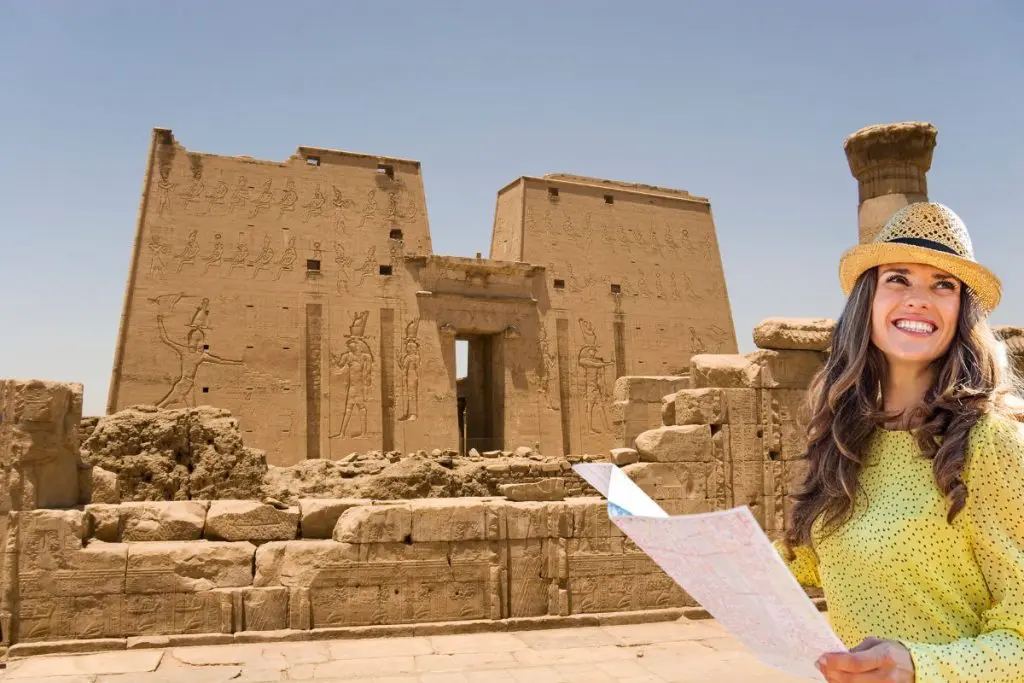
Who built Edfu temple?
The specific pharaoh associated with the construction of Edfu Temple is Ptolemy III Euergetes I. The temple was not completed during his reign but was continued by subsequent Ptolemaic rulers, including Ptolemy IV Philopator and Ptolemy VII Physcon, and finally completed during the Roman period under the rule of Emperor Augustus. The temple’s construction spanned several reigns, reflecting the enduring commitment to its completion by different rulers over time.
Facts about Edfu temple of Egypt
- Dedication:
- Edfu Temple is dedicated to the falcon-headed god Horus, one of the most important deities in ancient Egyptian mythology.
- Location:
- Situated on the west bank of the Nile River in the city of Edfu, the temple is part of the ancient city of Apollinopolis Magna.
- Construction Period:
- The temple was built during the Ptolemaic period, specifically between 237 and 57 BCE, making it one of the best-preserved temples from that era.
- Architectural Style:
- Edfu Temple is an excellent example of traditional Egyptian temple architecture, featuring a pylon entrance, courtyard, hypostyle hall, and inner sanctuaries.
- Pylon and Courtyard:
- The entrance pylon of Edfu Temple is adorned with reliefs depicting historical and mythological scenes. The courtyard is surrounded by a colonnade with statues and reliefs.
- Hypostyle Hall:
- The temple boasts an impressive hypostyle hall with towering columns, each intricately decorated with hieroglyphics and reliefs illustrating the “Feast of the Beautiful Meeting.”
- Horus and Hathor Chapels:
- Within the temple complex, there are chapels dedicated to both Horus and Hathor. Hathor was associated with music, dance, and love, while Horus was revered as a sky god and protector.
- Famous Festival:
- Edfu Temple was the focal point for the annual “Feast of the Beautiful Meeting,” a significant celebration reenacting the mythological union of Horus and Hathor.
- Hidden Sanctuary:
- The innermost part of the temple houses the holy of holies, a sacred sanctuary where the cult image of Horus was kept. Access to this area was restricted to priests.
- Well-Preserved Inscriptions:
- Edfu Temple is renowned for its well-preserved inscriptions and reliefs that provide valuable insights into ancient Egyptian religious beliefs, rituals, and daily life.
Visiting Edfu temple
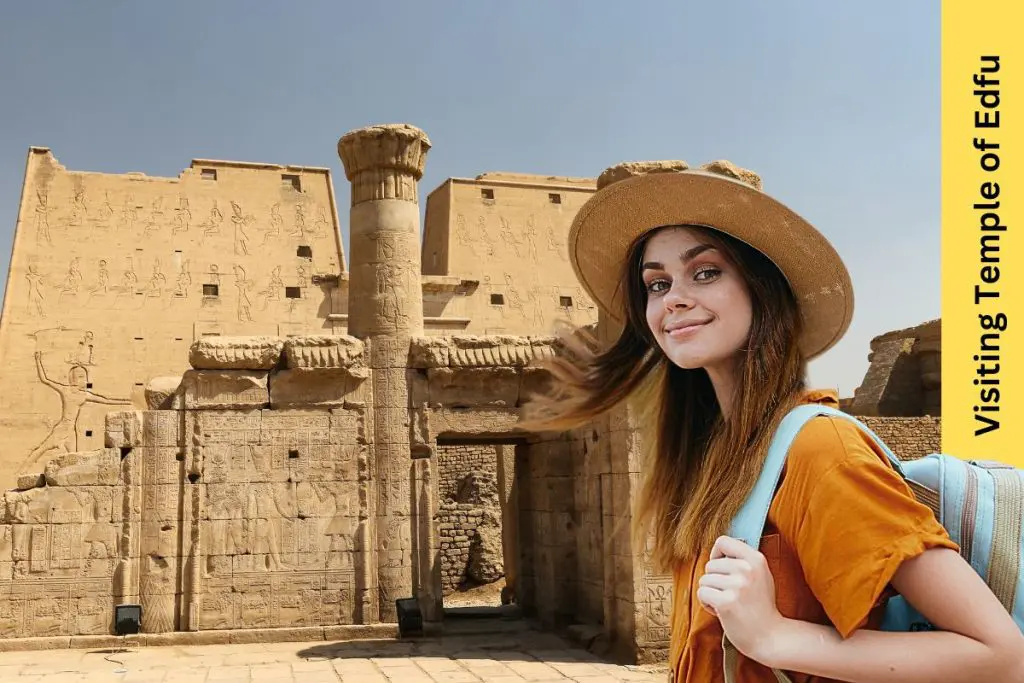
Operating Hours of Edfu Temple:
- The temple is open from 7 am to 4 pm, October through May, and from 7 am to 5 pm, June through September.
Weather in Edfu:
- Winter temperatures range from 16 to 18 °C (62°F) between December and February, while summer sees highs of 34 °C (93°F) in July and August. The air is dry, so pack light, breathable clothing like thin shirts and dresses. Comfortable shoes are recommended for exploring the Temple of Edfu.
Accommodation Near Edfu Temple:
- Accommodations in the town of Edfu are limited. Consider staying in tourist hotels in nearby Luxor and Aswan for a comfortable stay during your visit.
Kom Ombo Temple
The Kom Ombo Temple, situated along the Nile in Upper Egypt, is a unique ancient Egyptian temple dedicated to two deities: Sobek, the crocodile god, and Horus, the falcon-headed god. Constructed during the Ptolemaic dynasty (180–47 BCE), the temple’s distinctive feature is its symmetrical design, with mirrored halls and sanctuaries for each deity. Intricate reliefs and carvings depict medical instruments, emphasizing the site’s role as a healing center. The Nile-side location underscores Sobek’s association with fertility and protection. Kom Ombo Temple stands as an archaeological marvel, offering insights into ancient religious practices and the fusion of diverse Egyptian beliefs.
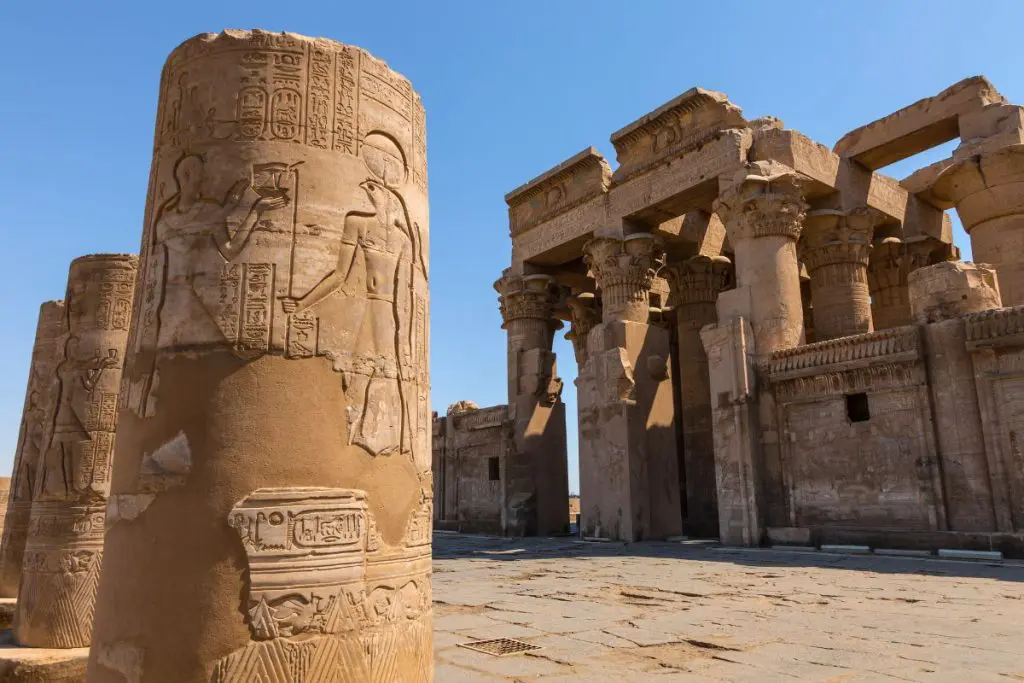
Who build Kom Ombo temple of Egypt
Ptolemy VI Philometor is believed to have initiated it, and subsequent rulers, including Ptolemy XIII, Ptolemy XV (Caesarion), and the Roman Emperor Augustus, played a part in completing it. Various rulers marked the site over several centuries. People ascribe the construction of the Kom Ombo Temple in Egypt to the Ptolemaic and Roman periods. The uniqueness of the Kom Ombo Temple lies in its double dedication to two deities: Sobek (the crocodile god) and Horus the Elder.
Facts about Kom Ombo temple
Here are some facts about the Kom Ombo Temple in Egypt:
- Double Temple:
- Kom Ombo is a unique double temple, dedicated to two gods: Sobek, the crocodile god associated with fertility and protection, and Horus the Elder, the falcon-headed god of war and the sky.
- Location:
- Situated in the town of Kom Ombo, near the city of Aswan, the temple overlooks the Nile River. Its strategic location is both historically and architecturally significant.
- Ptolemaic and Roman Influence:
- The construction of Kom Ombo Temple dates back to the Ptolemaic period, with contributions from rulers like Ptolemy VI Philometor and Ptolemy XIII. The Roman Emperor Augustus also played a role in its completion.
- Symmetrical Design:
- The temple has a symmetrical design, with duplicated halls, sanctuaries, and entrances dedicated to Sobek and Horus. This dual structure is a distinctive feature of Kom Ombo.
- Crocodile Mummies:
- Sobek, the crocodile god, was worshipped at Kom Ombo, and crocodile mummies have been discovered in the vicinity. Crocodiles were considered sacred in ancient Egyptian religion.
- Healing and Surgical Instruments:
- The temple features reliefs and inscriptions depicting medical instruments, suggesting that Kom Ombo was associated with healing practices. It is believed that the temple may have served as a healing center.
- Nilometer:
- Kom Ombo Temple includes a Nilometer, an ancient device used to measure the water level of the Nile River. This information was crucial for assessing agricultural conditions.
- Festivals and Rituals:
- The temple was the site of various festivals and rituals dedicated to Sobek and Horus. Pilgrims and worshippers would come to participate in religious ceremonies.
- Hieroglyphics and Carvings:
- The walls of Kom Ombo Temple are adorned with intricate hieroglyphics and carvings that depict religious scenes, mythological stories, and historical events.
- Current State:
- While parts of Kom Ombo Temple are well-preserved, some areas have suffered damage over the centuries. Despite this, it remains a significant archaeological site and a testament to ancient Egyptian religious practices.
Visiting Kom Ombo temple
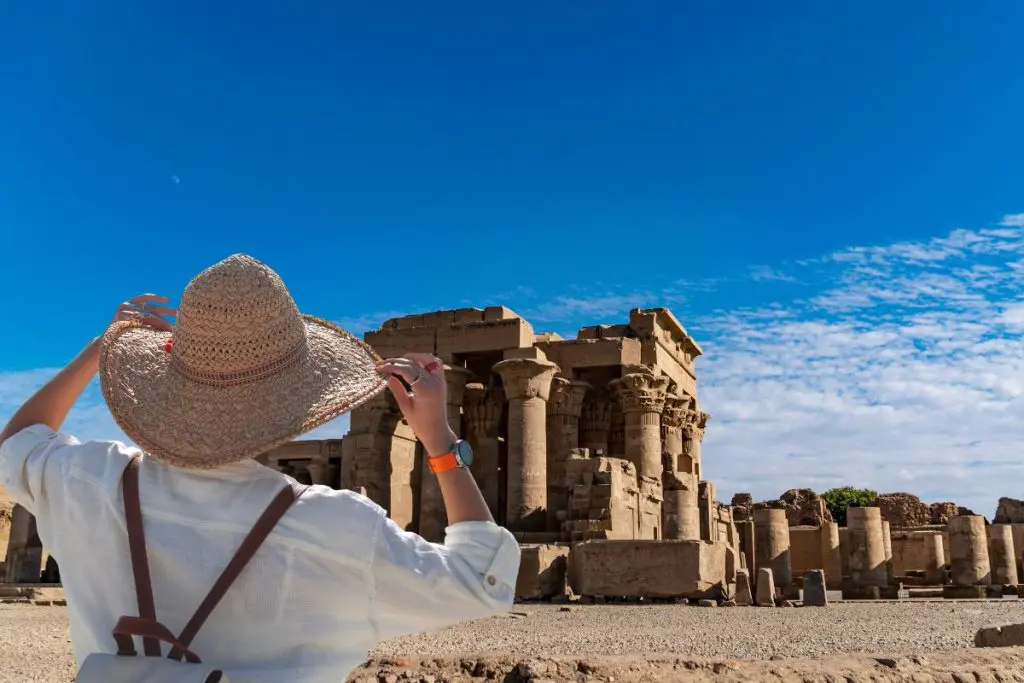
Navigating to the Kom Ombo Temple is seamlessly integrated into the Nile cruise itinerary. If your journey originates in Luxor, this ancient temple becomes one of the final stops en route to Aswan. Conversely, if your cruise embarks from Aswan, Kom Ombo will be the initial point of interest.
While opting for a cruise is the preferred method, independent travelers can reach Kom Ombo by train, thanks to the well-connected Kom Ombo train station linking to major Egyptian cities. Upon arrival, a convenient cab ride will take you to the temple area.
Plan your visit within the operating hours: Monday to Friday, 8:00 am to 5:00 pm, and on Saturdays and Sundays, from 8:00 am to 4:00 pm. Whether part of a cruise or a solo exploration, the Temple of Kom Ombo promises an enriching historical experience.
Luxor Temple
Luxor Temple, located on the east bank of the Nile in Egypt, is an ancient marvel dating back to around 1400 BCE. Dedicated primarily to the Theban Triad—Amun, Mut, and Chons—it served as a center for religious ceremonies and festivals. The temple’s grandeur is evident in its colossal statues, massive pylons, and intricate hieroglyphs. Notable structures include the Avenue of Sphinxes connecting Luxor Temple to Karnak Temple. Throughout millennia, various pharaohs contributed to its expansion and adornment. Luxor Temple stands as a testament to the architectural prowess and religious significance of ancient Thebes, the modern-day Luxor.
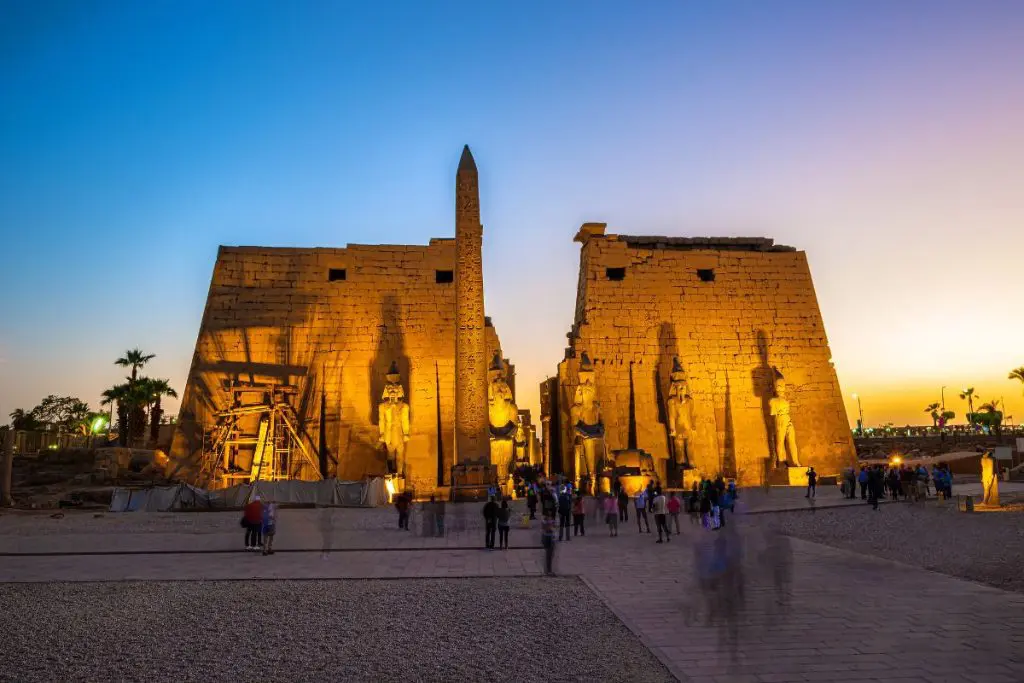
Who built Luxor temple of Egypt
The temple’s construction was initiated by Amenhotep III (1386–1353 BCE) of the 18th Dynasty, and it was dedicated to the god Amun.
Several pharaohs built Luxor Temple in Egypt over many centuries. Different pharaohs from various dynasties expanded and modified it, rather than being constructed by a single ruler.
Later pharaohs, such as Tutankhamun, Horemheb, and Ramesses II, made significant additions and alterations to Luxor Temple during the New Kingdom period. Ramesses II, in particular, added the famous entrance colonnade known as the Luxor Temple Colonnade.
The temple continued to be modified by subsequent rulers, including the Greeks and Romans, reflecting the complex and layered history of ancient Egypt. As a result, Luxor Temple stands as a remarkable testament to the continuity and evolution of Egyptian religious and architectural practices over the centuries.
Facts about Luxor temple
Here are some key facts about Luxor Temple in Egypt:
- Location:
- Luxor Temple is located on the east bank of the Nile River in the city of Luxor, once known as Thebes, the ancient capital of Egypt.
- Ancient Name:
- The temple was originally known as “Ipet resyt” in ancient Egyptian, meaning “Southern Sanctuary.” It was linked to the larger complex of Karnak Temple via the Avenue of Sphinxes.
- Construction Period:
- Luxor Temple’s construction was initiated by Pharaoh Amenhotep III of the 18th Dynasty (circa 1386–1353 BCE). It was further expanded and modified by subsequent pharaohs, including Tutankhamun, Horemheb, and Ramesses II.
- Purpose:
- Luxor Temple served various religious purposes, including the worship of the god Amun. It was also the site of the annual Opet Festival, a significant religious celebration.
- Avenue of Sphinxes:
- A processional avenue lined with sphinx statues once connected Luxor Temple to Karnak Temple. This avenue played a role in the Opet Festival and was adorned with various rituals and processions.
- Colonnade of Amenhotep III:
- The temple features a Colonnade built by Amenhotep III, consisting of a series of large open courtyards and towering columns. Ramesses II later added an entrance colonnade, enhancing the temple’s grandeur.
- Obelisks:
- Originally, Luxor Temple was adorned with a pair of obelisks, one of which is now located in the center of the Place de la Concorde in Paris, France. The other remains at the temple.
- Later Additions:
- The temple continued to be modified by subsequent rulers, including the Greeks and Romans, who added their own structures to the site.
- Religious Significance:
- Luxor Temple was dedicated to the rejuvenation of kingship and was believed to be the place where pharaohs were crowned and celebrated their divine birthright.
- Modern Significance:
- Today, Luxor Temple is a UNESCO World Heritage Site and a popular tourist attraction, attracting visitors with its historical and architectural significance. The annual Luxor African Film Festival is also hosted in the temple precinct.
Visiting Luxor Temple
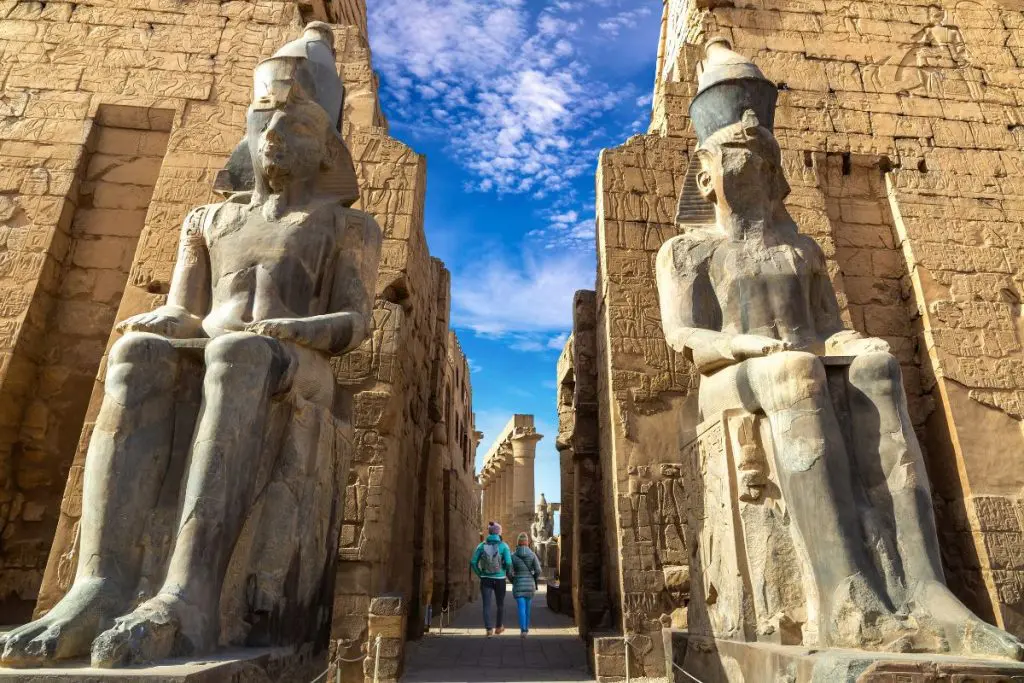
Luxor is accessible by direct flights or trains from various Egyptian cities such as Alexandria, Cairo, and Hurghada. If cruising the Nile from south to north, a boat journey from Aswan will lead you to Luxor.
Exploring Luxor Temple:
The temple welcomes visitors daily from 6 am to 10 pm. To fully appreciate its splendor, plan for approximately 3 hours, considering possible time constraints if part of a guided Nile cruise tour.
Optimal Times For Luxor Temple:
Witness the illuminated beauty of Luxor Temple at night, offering a cooler ambiance. For daytime visits, early mornings are advisable to escape intense heat after 10 am. Remember essentials: sunscreen, head cover, and a water bottle for a comfortable experience.
Temple of Khonsu
The Temple of Khonsu, situated within the Karnak Temple complex in Luxor, Egypt, is a small but significant religious structure dedicated to the moon god Khonsu. Constructed during the New Kingdom period (1184–1153 BCE), it features a unique architectural style with well-preserved decorations and reliefs. The temple comprises a vestibule, hypostyle hall, and sanctuary. Elaborate carvings depict religious scenes and pharaonic rituals, showcasing the craftsmanship of ancient Egyptian artisans. The Temple of Khonsu reflects the religious fervor of the New Kingdom and serves as a testament to the cultural and architectural achievements of this period in Egyptian history
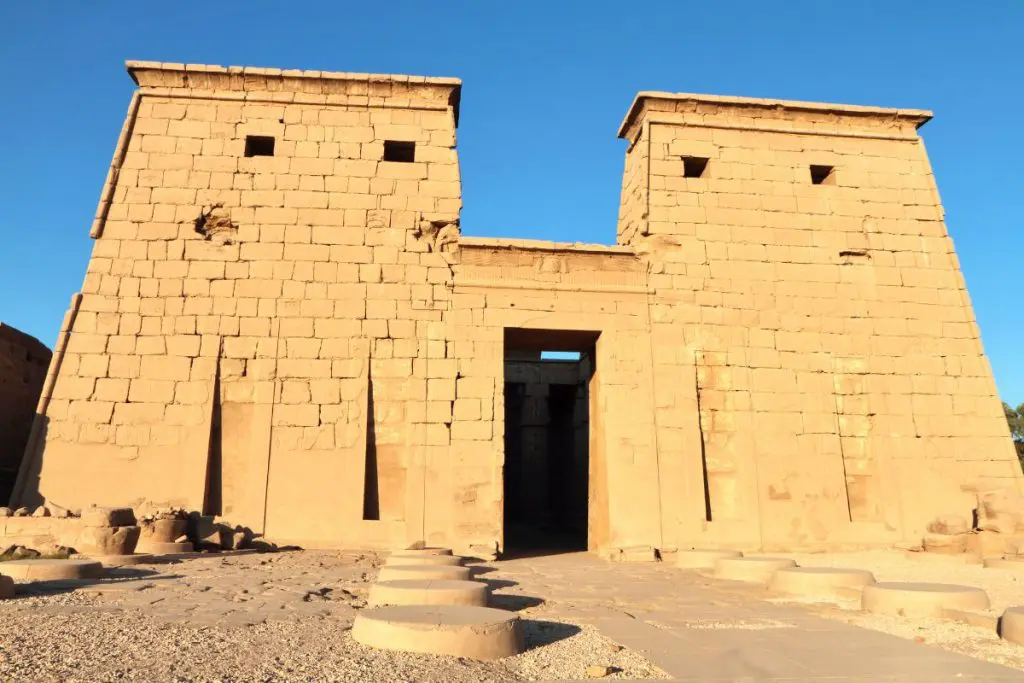
Who built temple of Khonsu
Temple Of Khonsu was built during the New Kingdom period, specifically during the 20th Dynasty, under the rule of Pharaoh Ramses III.
The Temple of Khonsu, also known as the Khonsu Temple or the Temple of Khons, is part of the Karnak Temple complex in Luxor, Egypt.
Ramses III was a prolific builder and undertook numerous construction projects during his reign, including the construction of the Temple of Khonsu. The temple is dedicated to the god Khonsu, who was associated with the moon and considered a deity of healing and restoration.
The construction of the Temple of Khonsu reflects the religious and architectural practices of ancient Egypt during the New Kingdom period. Today, the temple is a significant archaeological site within the Karnak Temple complex, offering insights into the religious beliefs and practices of that era.
Facts about temple of Khonsu
here are some key facts about the Temple of Khonsu:
- Location:
- The Temple of Khonsu is situated within the Karnak Temple complex on the east bank of the Nile River in Luxor, Egypt.
- Dedication:
- The temple is dedicated to the god Khonsu, the lunar deity in ancient Egyptian religion. Khonsu was associated with the moon and often depicted as a youthful figure.
- Construction Period:
- The temple was built during the New Kingdom period, specifically during the 20th Dynasty. Pharaoh Ramses III is credited with its construction.
- Architectural Features:
- The temple exhibits traditional Egyptian architectural elements, including a pylon entrance, a courtyard, hypostyle hall, and inner sanctuaries. The hypostyle hall is supported by columns adorned with hieroglyphic inscriptions.
- Purpose:
- Like many temples in ancient Egypt, the Temple of Khonsu served as a place of worship and ritual. It was dedicated to seeking the favor and blessings of the god Khonsu.
- Religious Significance:
- Khonsu was revered as a god of healing and restoration, and the temple likely played a role in healing rituals and ceremonies. Pilgrims and worshipers sought the intercession of Khonsu for health and well-being.
- Decorative Elements:
- The temple’s walls and columns are adorned with intricate carvings and reliefs depicting religious scenes, offerings to the gods, and representations of the pharaoh making offerings to Khonsu.
- Connection to Other Temples:
- The Temple of Khonsu is part of the larger Karnak Temple complex, connected to the main Karnak Temple by an avenue of sphinxes. The complex as a whole was dedicated to multiple deities.
- Ongoing Study:
- The Temple of Khonsu, like many ancient Egyptian temples, has been the subject of ongoing archaeological study and restoration efforts to preserve its historical and cultural significance.
- Visitor Access:
- Visitors to Luxor and the Karnak Temple complex can explore the Temple of Khonsu as part of their journey through the ancient Egyptian religious and architectural landscape.
Visiting temple of Khonsu
The Temple of Khonsu is located within the Karnak Temple complex on the east bank of the Nile River in Luxor, Egypt. To get there, you can:
1. Fly to Luxor:
- Luxor has an international airport (Luxor International Airport) that is well-connected to major cities. From the airport, you can take a taxi or use other transportation options to reach the Karnak Temple complex.
2. Take a Train:
- Luxor is accessible by train from various cities in Egypt, including Cairo and Aswan. The Luxor train station has good connections, and you can take a taxi or other local transportation from there to the Karnak Temple..
3. Nile Cruises:
- Many tourists visit Luxor as part of a Nile cruise. If you’re on a cruise, your journey might include a stop in Luxor, allowing you to explore the Karnak Temple complex, including the Temple of Khonsu.
Visiting Hours for Temple Of Khonsu:
- The visiting hours for the Karnak Temple complex, including the Temple of Khonsu, are typically from early morning to the early evening. Exact hours may vary, so it’s advisable to check with local authorities or the official website for the most up-to-date information.
- Generally, the Karnak Temple complex opens around 6:00 AM and closes in the late afternoon or early evening, depending on the season. The complex may have extended hours during special events or certain times of the year.
- It’s also worth noting that visiting times can be influenced by factors such as holidays or maintenance, so it’s a good idea to confirm the schedule before planning your visit.
Temple of Dakka
The Temple of Dakka is situated in Nubia, Egypt, is an ancient Egyptian temple devoted to the deities Thoth and Horus. Its meticulously preserved reliefs and inscriptions vividly portray pharaonic rituals and divine scenarios. As part of a UNESCO-led initiative to rescue Nubian monuments from the encroaching waters of Lake Nasser, the Temple of Dakka was relocated to its present site. This move not only safeguards the temple but also underscores its significance as a testament to ancient religious customs and the remarkable architectural prowess of the time.
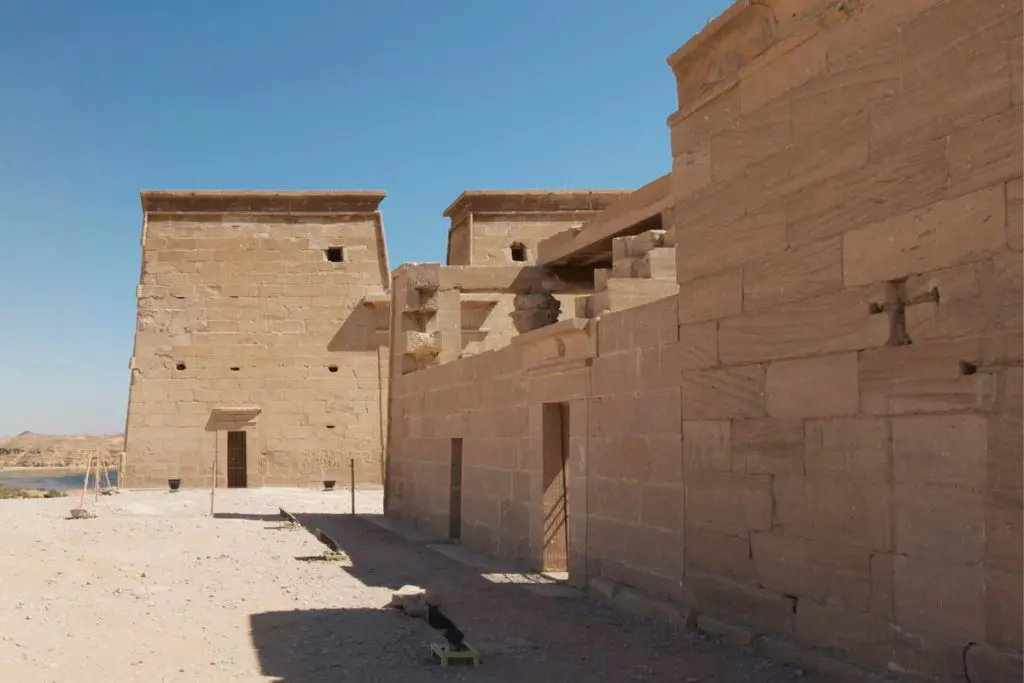
Who built temple of Dakka
The Temple of Dakka in Egypt was originally built during the reign of Ptolemy II (283–246 BCE), a ruler of the Ptolemaic Kingdom. Ptolemy II initiated the construction of the temple dedicated to the gods Thoth and Horus. The temple was later expanded and modified by subsequent rulers. It’s important to note that the temple, like many ancient Egyptian structures, underwent additions and renovations over time by different pharaohs and leaders.
Facts about temple of Dakka
- Location: The Temple of Dakka is located in Lower Nubia, in modern-day Egypt, near the town of Dakka.
- Construction Period: The temple was originally constructed during the reign of Ptolemy II (283–246 BCE), a ruler of the Ptolemaic Kingdom, and was dedicated to the gods Thoth and Horus.
- Architectural Features: The temple follows traditional Egyptian architectural design, featuring structures like a pronaos, offering halls, and a sanctuary. It also includes well-preserved reliefs and inscriptions.
- Religious Significance: Dedicated to Thoth, the god of wisdom, and Horus, the falcon-headed god associated with kingship, the temple played a role in religious rituals and practices of ancient Egypt.
- Relocation: In the 1960s, the temple was moved to its current location on the Aswan High Dam’s artificial island of Agilkia. This relocation was part of UNESCO’s efforts to salvage Nubian monuments threatened by the rising waters of Lake Nasser due to the construction of the dam.
- UNESCO Campaign: The move was part of the larger UNESCO-led campaign known as the Nubia Campaign, which aimed to save and relocate several ancient temples and monuments in Nubia before the completion of the Aswan High Dam.
- Preservation: The Temple of Dakka stands as a testament to the successful preservation efforts, showcasing both the historical and architectural significance of ancient Egyptian religious structures.
Visiting temple of Dakka
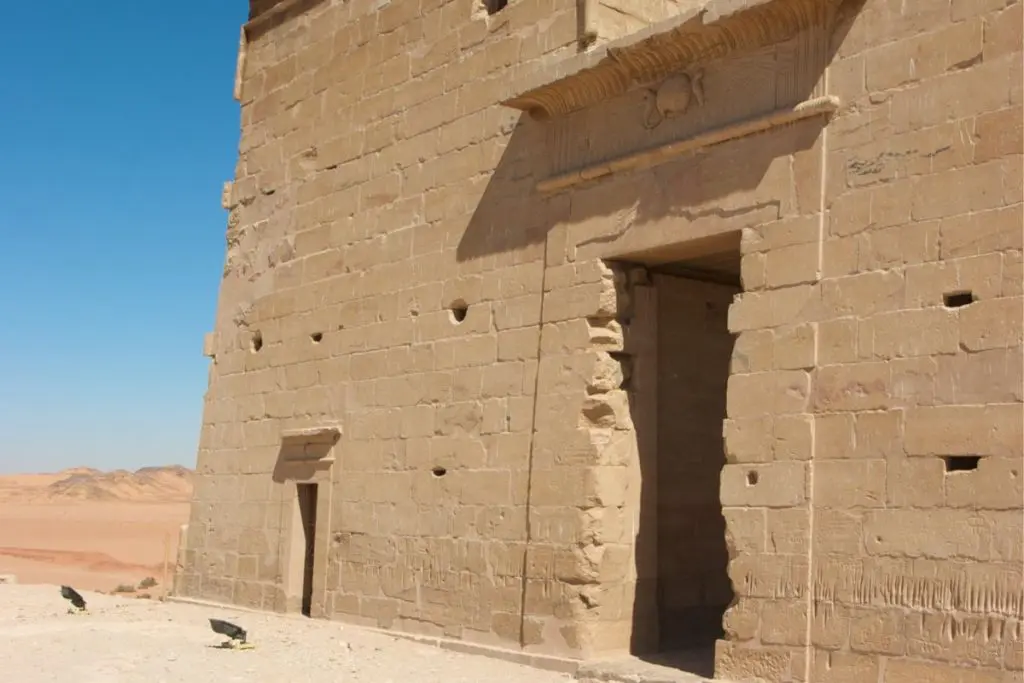
Organize a Tour or Cruise:
Many visitors choose to join guided tours or Nile River cruises that include visits to the temples in the Lake Nasser region. Tour operators often organize trips to the Temple of Dakka along with other nearby temples.
Private Transportation:
If you prefer a more independent journey, you can arrange private transportation from Aswan to the Lake Nasser area. This might involve hiring a taxi or a private car.
Boat or Ferry Ride:
Since the temple is located on the island of Agilkia in Lake Nasser, you may need to take a boat or ferry to reach the island.
Quick tips to before your visit to Temples in Egypt
Wear comfortable clothing and footwear suitable for walking, as you may explore different areas within the Temple complex.
Consider hiring a local guide to enhance your understanding of the historical and cultural significance of the Temples and the entire complex.
Bring essentials like sunscreen, a hat, and a water bottle, especially if you plan to explore during the warmer parts of the day.
Always check with local authorities or the official website for the most accurate and current information regarding visiting hours and any potential restrictions.
Resources: https://en.wikipedia.org/wiki/Egyptian_temple
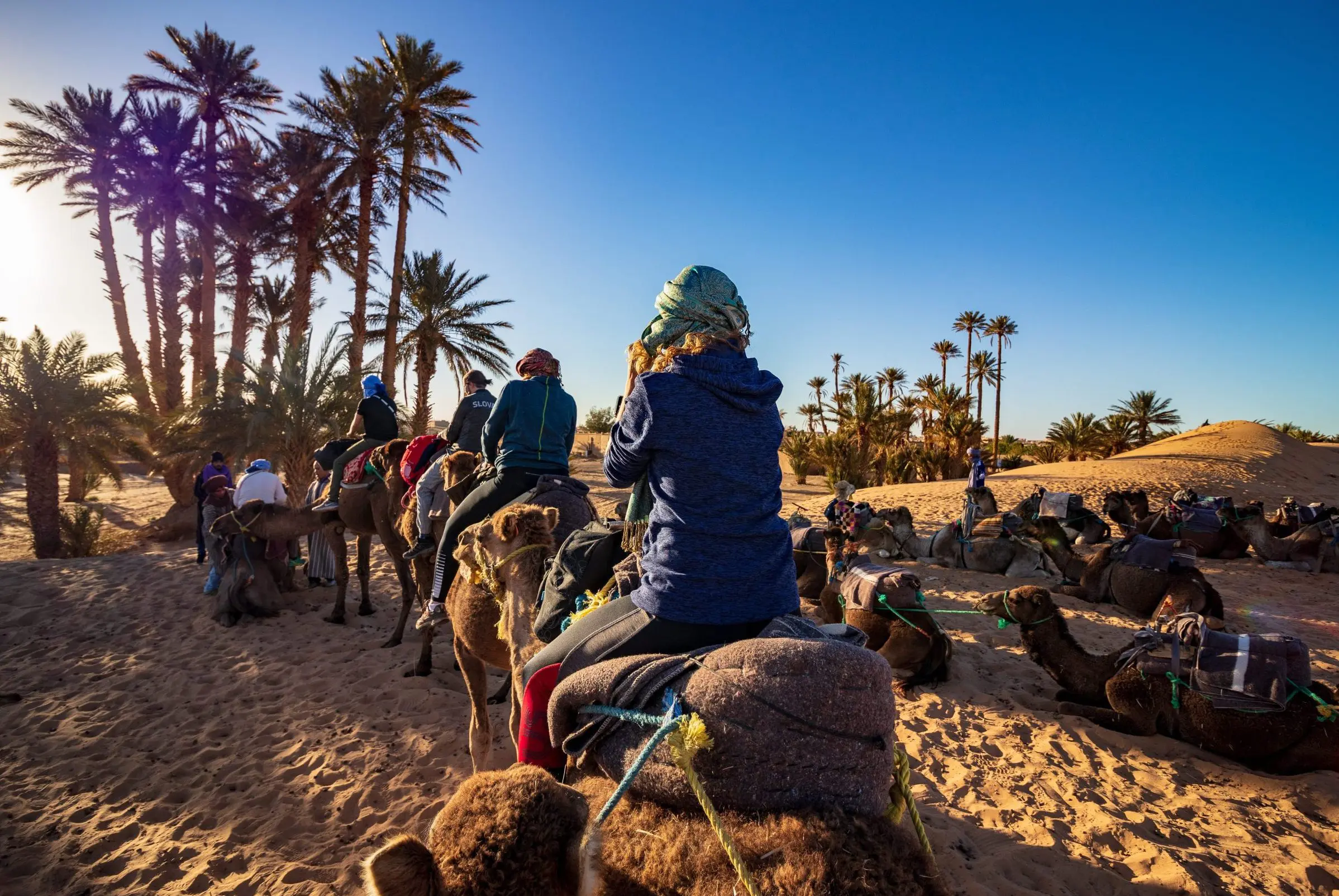 October Sale: 50% Off
October Sale: 50% Off Croatia Sailing 2025: 50% Off
Croatia Sailing 2025: 50% Off ANZAC Day Trips : Save 40%
ANZAC Day Trips : Save 40% 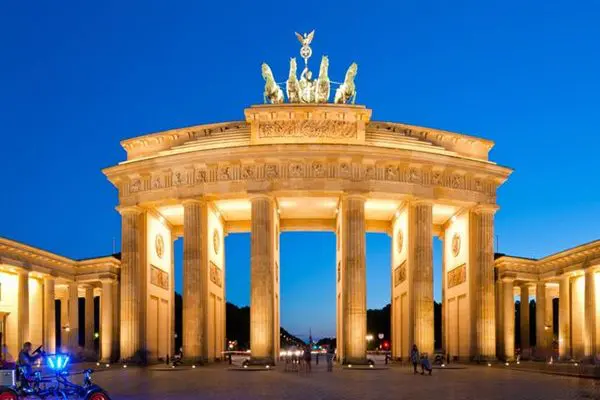 Central & Eastern Europe Tours: 50% Off
Central & Eastern Europe Tours: 50% Off  Why Travel Talk
Why Travel Talk Travel Talk Blog
Travel Talk Blog Responsible Travel
Responsible Travel Fair Travels with Travel Talk
Fair Travels with Travel Talk